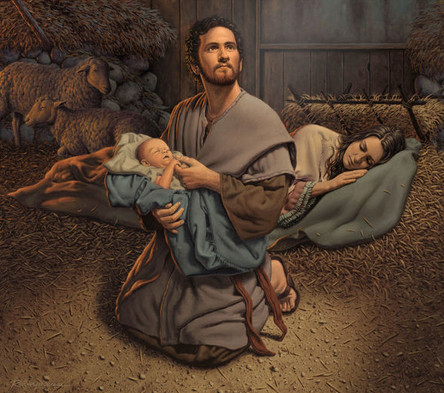Endings and New Beginnings
The Christmas Season gives us a unique opportunity to focus our attention on "endings" and "new beginnings." Within a short period of time we gather together to celebrate three special feasts of the Church - The Holy Family, Mary Mother of God and the Epiphany of the Lord. We join with one another to evaluate the end of another year of our pilgrimage in faith and to set our sights on the beginning of a new dimension of our call to discipleship.
 The feast of the Holy Family is a celebration of all families: not perfect families, not constantly serene families… but families just like ours. If we picture the family of Joseph of Nazareth as we have seen them depicted in works of art or statuary, it becomes very difficult to model our family lives around theirs. One of my favorite images of the Holy Family is a painting by Roger Loveless entitled "Be Thou My Guide" (https://www.rogerlovelessart.com/) In its very simplicity it displays the symbolism of the love being shared between the nervous husband, the sleeping wife, and the newborn child.
The feast of the Holy Family is a celebration of all families: not perfect families, not constantly serene families… but families just like ours. If we picture the family of Joseph of Nazareth as we have seen them depicted in works of art or statuary, it becomes very difficult to model our family lives around theirs. One of my favorite images of the Holy Family is a painting by Roger Loveless entitled "Be Thou My Guide" (https://www.rogerlovelessart.com/) In its very simplicity it displays the symbolism of the love being shared between the nervous husband, the sleeping wife, and the newborn child.
They were, in fact, ordinary working people, called to an extraordinary mission. They were a typical Middle-Eastern family, living in their own homeland, subjugated by a foreign power, simply trying to survive each day as it came. And they were subject to the ordinary failures of miscommunication, disappointments, worries, and disagreements of every family. “Ordinary families” have more than enough pressure on them in their daily lives, as we all know too well. The Holy Family was not immune to this.
However, they put their entire future, their entire trust, in the Spirit of God, who not only led them through their lives, but traveled alongside with them on their journey. Theirs was a family of faith and love, respect and honesty, but not without turmoil.
Mary, as the mother of our God, becomes our mother. It is she in whose arms the Babe nestled at birth, and in whose arms the crucified Son lay at the foot of the Cross. "Mary, the Mother of God" is perhaps the most significant of her titles... an ordinary teen-aged girl called to bring forth the Word of Salvation - to care for Him, to nurture Him, to feed Him with the fruits of this life, so that He could feed others with the gift of Eternal Life.
Mary's presence in the Advent/Christmas experience makes our fears and anguish comprehensible. The uncertainty of life is overcome by the sure hope of God's coming to those who are waiting. The angel makes the announcement, Mary accepts. No guidance is given. Questions are left unanswered and we can assume that Mary is more confused than ever. Life as she knows it has ended and something totally "new" is at hand.
And yet Mary comes to symbolize God's coming into our hearts with his transforming presence. Longing for the light eventually brings the light. Faith opens into trust and trust is not disappointed because the love of God is poured forth in the hearts of the brokenhearted.
Epiphany is a new beginning and it takes several forms. Magi come from afar and a new revelation of salvation comes to light. Yet in another epiphany, the hushed-tones of Bethlehem shift to explosive manifestations about Jesus. The magi cause quite a stir with their arrival at Herod's palace, and their question about the "newborn king of the Jews." Thus, a new beginning for the young and holy family, in a foreign land as exiles.
Still, the prophet Isaiah insists, God had not forgotten us. He continues, “but upon you the Lord shines and over you appears his glory.” It doesn’t always feel that way in our own darknesses. It probably didn’t feel that way for the people Isaiah originally addressed who had returned to Jerusalem. And we can be sure it didn't feel that way for Joseph and Mary when they made their escape into the darkness. Isaiah simply points the out signs of God’s presence, “but upon you the Lord shines.”
Epiphany awakens us from any glow that might remain from our Christmas celebrations. It celebrates the manifestation of the Incarnation to the whole universe. It embraces the fuller dimensions of the role of the Word-made-flesh - His coming to bring the nations together in peace, His coming to reveal the Father, His coming to change, almost miraculously, the quality of life for all people, His coming to be a light in the darkness.
The Season of Advent ushered in the new liturgical year. Christmastime reflects our affirmation of God made flesh, and we now begin the cycle anew. We can put aside the past, let ourselves be guided by the gospel narrative and make our journey to the place where our truth can be found. This is the time for people willing to let go of whatever holds our spirits back, start all over again, and make the journey in the direction of the one who gives us new vision. These are feasts of universality, where all are welcome to God’s saving embrace. Leaving the past behind and looking forward, we have nothing to fear.